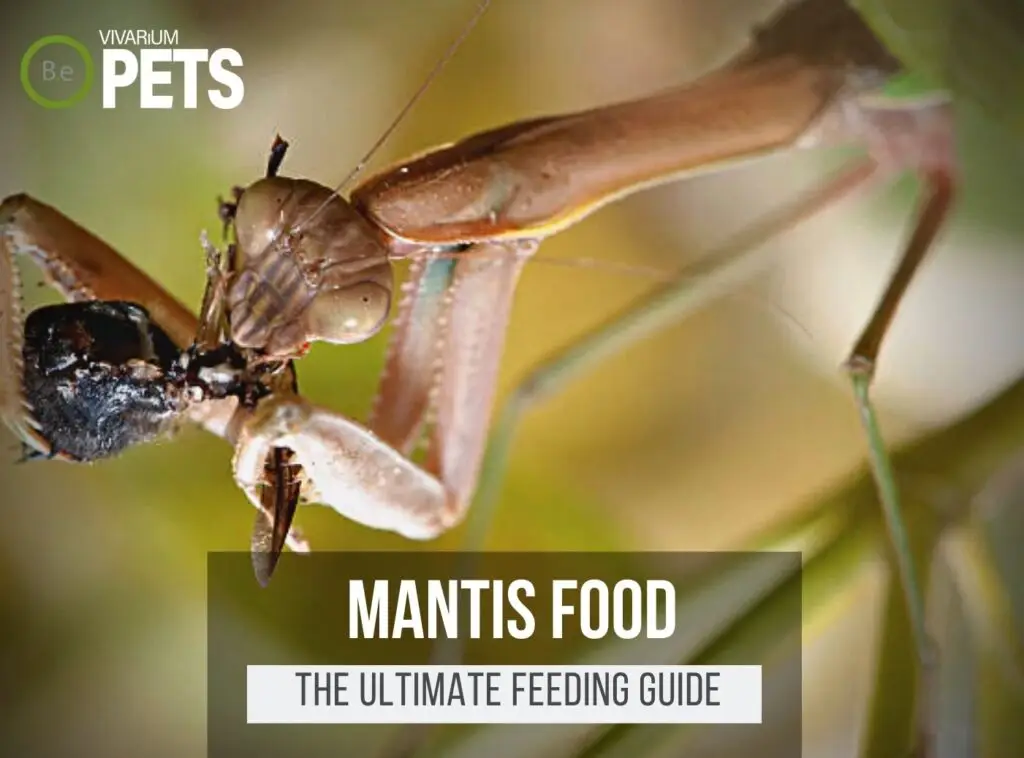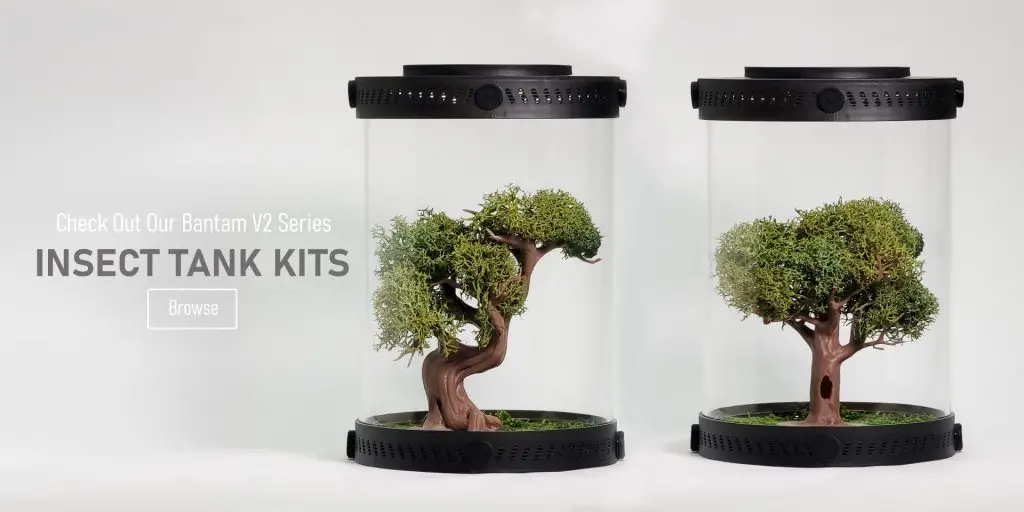The Spiny Flower Mantis is a chunky flamboyant predator that looks like something straight out of a Dr. Seuss book!
If you’ve got your mind set on raising one of these exuberant flower mantes, then you are in the right place.
Pseudocreobotra wahlbergii is an impressive and fascinating species of mantis that’s easy to care for, making it an ideal type of flower mantis.
Read on to learn all the essentials for caring for your new spiny companion.
Table Of Contents:
ToggleWhat Is A Spiny Flower Mantis?
Pseudocreobotra wahlbergii is in the family of Hymenopodidae – an order of mantis known for their distinctive resemblance to flowers.
These fascinating insects are found in tropical rainforests in Africa and they get their name from their spiny ridged wings resembling delicate flowers.
These fragile-looking mantises range in size but typically grow to be almost two inches in body length.
They have large, brightly colored eyes and long antennae for sensing their prey.
Spiny Flower Mantis come in a wide range of colors which makes it especially fun to watch them hunt.
What Does A Spiny Flower Mantis Look Like?
Pseudocreobotra wahlbergii has an impressive and unmistakable appearance.
They can be easily recognized for their extended mandibular spikes, large eyes, and colorful wings.
The adults typically grow to a length of 1 inch but can reach up to 1.5 inches in some cases.
The colors of the species range from green to yellow, to pink and other hues.
Each individual has a unique color pattern on its wings, with the forewings typically having a salmon-colored base with intricate patterns in yellow, green, brown, or black.
The hind wings are often clear but can also have various discolorations.
The eyes of the Spiny Flower Mantis are large, round, and dark.
This mantis also has long, thin antennae on its head and two long, powerful raptorial forelegs that are used for capturing and holding prey.
The long, spiked abdomen of the mantis is its most distinctive feature.
The spikes are typically white but can have other colors depending on the particular individual.
Benefits Of Using A Spiny Flower Mantis
Spiny Flower Mantises are perfect for use in vivariums as they offer unique and fascinating visuals and behaviors for visitors to enjoy.
These mantises can be beneficial in controlling populations of insect pests, making them the ideal inhabitants of micro-ecosystems.
They are also quite easy to care for, requiring little maintenance.

Spiny Flower Mantis Facts
Pseudocreobotra wahlbergii has a unique insect-like appearance, with its diamond-shaped head, spiny antennae, and peculiarly mottled wings and thorax.
They are typically a light green or olive color, making them interesting to observe.
These insects are non-aggressive to humans and eat mostly small invertebrates, including other insects and spiders.
Spiny Flower Mantises have a lifespan of a little over a year and can be bred in captivity given the proper conditions.
Habitat
Pseudocreobotra wahlbergii is native to southeastern Africa, ranging across East Africa, from South Sudan to Tanzania.
They inhabit forests, woodlands, and grasslands, though some subspecies can be found in more arid regions.
They are usually found on the ground, although they may climb low shrubs and trees.
These fascinating predators are active during the day, usually remaining in one spot until a meal is found.
By hiding and camouflaging themselves using their flower-like wings, Spiny Flower Mantises can easily ambush insects and even small lizards.
Diet
In their natural habitat, Spiny Flower Mantises are opportunistic predators and feed on insects like other mantises.
They mostly feed on smaller flying insects such as flies, mosquitos, and beetles, but they may also occasionally eat other arthropods such as spiders.
They use their long sensitive antennae to detect movement and capture their prey.
They will also eat fruits, vegetation, and nectar.
Temperament
One of the most appealing aspects of the Spiny Flower Mantis is its passive and calm temperament.
Despite their impressive size, these mantises are docile and rarely, if ever, attempt to hurt people.
Instead, they will often take up residence on the arm or shoulder of the person caring for them, or simply observe their activity from a distance.
They do not bother other animals either, and can peacefully co-exist with cats, dogs, and other non-threatening creatures in the same home.
It is not uncommon for Pseudocreobotra wahlbergii to follow one’s finger with their head or antennae and even take food right from the hand, so long as they are comfortable and not startled.
Lifespan
Spiny Flower Mantises is one of the most long-lived species of mantids, with an average lifespan of 10 to 14 months.
These mantises go through several stages of growth throughout their lives.
The first stage is the egg stage, in which eggs are laid and hatch.
From there, they enter the nymph stage, progressing through 6 instars during which they molt regularly.
As nymphs, they are most vulnerable, so proper care and attention must be taken to ensure that they can reach adulthood safely.
Once they have reached adulthood, they may mate, reproduce, and live out their days.
Breeding
The P. wahlbergii species are solitary, so they must be kept isolated during the non-breeding time of the year.
Generally, mating will take place during late summer or early fall, when temperatures are warm and there is ample food supply.
Once the male has been introduced to the female’s enclosure, they will mate and the female will produce an ootheca.
The female will lay her ootheca (or egg case) containing up to 200 eggs in an isolated area.
Nymphs will hatch about 2-4 weeks later, and after multiple stages of molting, will reach maturity in about 8 weeks.
It is important to ensure that the female is removed shortly after mating to prevent her from eating her partner.
If you do plan to keep the pair together, it is advised to provide plenty of food and separation using dividers or barriers.
Where To Find Spiny Flower Mantises
If you’re interested in finding Pseudocreobotra wahlbergii in the wild, it’s good to note that these animals often blend in well with their environment and can be hard to find!
If you’re looking to buy a mantis, your best bet is to visit your local pet store or do some online searching.
When you’re buying online, be sure to ask for a photo of the animal and make sure that it looks healthy before purchasing.
Spiny Flower Mantis Care
Caring for Pseudocreobotra wahlbergii requires providing them with an optimal environment, including appropriate temperature, humidity, and ventilation.
Properly housing and feeding them is critical to their health and growth, along with providing them with plenty of fresh water.
Additionally, breeding and molting processes should be monitored, and any health issues should be addressed as soon as possible.
Tank Requirements
Spiny Flower Mantises need an environment that mimics their natural habitat to survive.
To ensure they have the best chance of remaining healthy and active, their terrarium should be kept at 75 – 80°F, and should also have a relative humidity of 70 – 80%.
The pH of water offered should be between 6.5 and 8.0, and the hardness should remain between 3°-10°dH.
It is best to provide several inches of terrarium substrate for your mantis to burrow into, as well as plenty of leaves and other decorations that give it places to hide and climb.
Terrarium lighting should be provided for 12-14 hours each day. Keep the lights off at night to provide the mantis with the environment it needs to rest and digest its food overnight.
What Do Spiny Flower Mantises Eat?
Feeding Pseudocreobotra wahlbergii is an essential part of providing them with the best care.
It’s good practice to understand the species’ diet and be sure to provide them with the right foods that meet their nutritional needs.
Your Spiny Flower Mantis can typically be fed daily, and they will eat a variety of foods such as flies, crickets, moths, spiders, and beetles.
You can also provide them with fruits such as apples, peaches, and bananas.
For larger mantises, it can also feed them small pieces of meat such as ground beef, chicken, bacon, and salmon.
Be sure to keep feeder insects in a separate habitat and also be sure to feed your mantis healthy, fresh food.
As treats, you can also provide your mantis with nectar made from honey and water.
Remember to provide your mantis with fresh water daily and also monitor their food intake.
With a proper diet, your mantis will stay healthy and live a longer life.
If you’re looking for a more detailed approach to feeding these critters, be sure to check out my ultimate DIY Praying Mantis food guide. I give a more in-depth explanation of the best foods and my favorite recipe.
Best Tankmates For Spiny Flower Mantises
Spiny Flower Mantises often make good tankmates with insects of similar tank requirements.
Beneficial tankmates include Stick Insects, millipedes, Madagascar Hissing Cockroaches, terrarium snails, and isopods.
When introducing tankmates make sure to quarantine them, watch for signs of aggression, and be vigilant with cleanliness.
Conclusion
Caring for Pseudocreobotra wahlbergii can be a fun and rewarding experience.
With the proper setup, diet, and maintenance, you can enjoy having a healthy pet for a lifetime.
Make sure to always be observant and stay on top of any health issues that could arise.
Remember, with the right care, your pet praying mantis will be sure to live a long and active life!
Create the ideal habitat for your praying mantis with our species-specific soil mixes and Insect Enclosure Kits. These products provide everything you need for a thriving Mantid habitat.
Frequently Asked Questions
Yes, spiny flower mantises can be kept as pets, but they require specialized care, including specific temperature and humidity conditions, as well as a diet of live insects.
Female spiny flower mantises typically reach a size of around 1.5 inches in length, although some individuals may grow slightly larger.
Spiny flower mantises are not typically aggressive towards humans, but they can display territorial behavior and may exhibit aggression towards other mantises or prey.
Spiny flower mantises are insectivores and primarily feed on live insects such as flies, fruit flies, small crickets, and other soft-bodied insects.
Yes, spiny flower mantises require heat to maintain their metabolic functions and activity levels. They thrive in temperatures ranging from 75°F to 80°F with a humidity level of around 70% to 80%.
Spiny flower mantises do not have specific plant preferences as they primarily rely on their camouflage to blend with various flowers and foliage.
However, providing some natural or artificial plants in their enclosure can create a more enriched environment for them to hide and perch on.
Typically plants with soft foliage such as Mimosa, Rose, Begonia, and Dianthus are of better choice.
Yes, Spiny Flower Mantis are gentle and generally docile creatures that make fascinating pets.
Spiny flower mantises are not typically recommended for beginners due to their specialized care requirements and specific environmental needs, which can be challenging to meet without prior experience in keeping mantises or other insects as pets.




